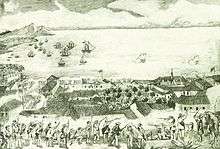Federal War
The Federal War (Spanish: Guerra Federal) — also known as the Great War or the Five Year War — was a civil war (1859–1863) in Venezuela between the Conservative party and the Liberal party over the monopoly the Conservatives held over government positions and land ownership, and their intransigence to granting any reforms. This drove the Liberals – known as the Federalists – to look for greater autonomy for the provinces: a new federalism for Venezuela, as it were. It was the biggest and bloodiest civil war that Venezuela had since its independence from Spain on 5 July 1811. Hundreds of thousands died in the violence of the war, or from hunger or disease, in a country with a population of just over a million people.
| Federal War | |||||||
|---|---|---|---|---|---|---|---|
 Combat of Maiquetía, during the beginning of the Federal War, 2 September 1859 | |||||||
| |||||||
| Belligerents | |||||||
|
Federalists |
Conservative Government | ||||||
| Commanders and leaders | |||||||
|
Ezequiel Zamora, Juan Crisóstomo Falcón Antonio Guzman Blanco |
José Antonio Páez Julián Castro | ||||||
Details
An account cited that the dictatorial rule of the Monagas brothers, Jose Tadeo Monagas and Jose Gregorio Monagas, precluded the chaos that led to the Federal War.[1] Their regimes created fiscal problems and enacted actions by the central government that curtailed the autonomy and authority of the Venezuelan provinces.[1]
The Federal War was primarily a guerrilla war fought largely without a centralized command for the Federalists, who professed to ride on social resentment. Just three major conventional battles were fought:
- The Battle of Santa Inés (10 December 1859), victory of the Federalist forces of Ezequiel Zamora and 3,400 men that defeated the Central Army of 2,300 men, with about 1,200 casualties altogether both sides;
- The Battle of Coplé (17 February 1860), victory of the Government forces of General León de Febres Cordero over a Federalist army of 4,500 men, commanded by Juan Crisóstomo Falcón; and
- The Battle of Buchivacoa (26–27 December 1862).
The hostilities ended with the signing of the Treaty of Coche in April 1863. The treaty was signed after the victory of Falcon, who formed a new coalition that included Antonio Guzman Blanco.[2] When the war finally ended, there were more than 100,000 deaths while the Venezuelan economy was decimated and mired in foreign debt.[2]
See also
References
- Denova, Hollis Micheal Tarver; Tarver, H. Micheal; Frederick, Julia C. (2005). The History of Venezuela. Westport, CT: Greenwood Publishing Group. p. 65. ISBN 0313335257.
- Salas, Miguel Tinker (2015). Venezuela: What Everyone Needs to Know®. Oxford: Oxford University Press. p. 46. ISBN 9780199783281.
